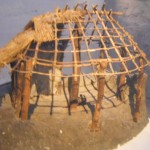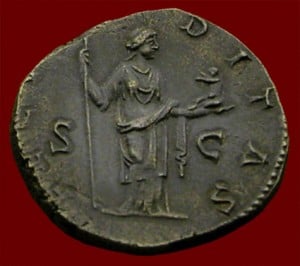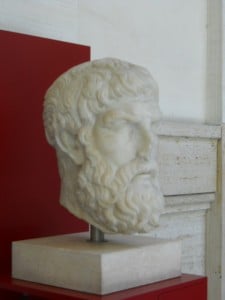Thirdly we come to a Postumnian Law that instructs us, “No sacrifices shall be performed without meal.”

This refers to what we call mola salsa in Latin. It is the product of an ancient method of preparing far, a type of winter wheat. Pliny the Elder tells us a couple things about the process. In one place he says, “Numa first established the custom of offering grain to the Gods, and of propitiating them with mola salsa; he was the first, too, as we learn from Hemina, to parch spelt, from the fact that, when in this state, it is more wholesome to dine on. This method, however, he could only establish one way: by making an enactment, to the effect that spelt is not in a pure state for offering, except when parched. He it was, too, who instituted the Fornacalia, festivals appropriate for the parching of kernels (Pliny H. N. 18.2.7-8).”
The process of preparing mola salsa begins during the week 7-14 May or from the First Quarter of the moon until the day before the Full Moon (nones to the ides). The mola salsa used by sacerdotes of the past was once made by the three eldest Vestal Virgins. But before they took that step a yearlong cycle had taken place. The younger Vestal Virgins had first been sent out into the fields of winter wheat to ritually harvest the first ripened grains. As with other Roman rituals, this would have entailed setting up an altar, which is a ritual in itself, offering oblations on the altar, and initiating a sacrifice. An action such as harvesting the first fruits of wheat or grapes is always performed during a sacrifice; the sacrifice is completed after the action has been made. The harvested wheat would then be processed in the usual manner, stored and dried for later use. After mentioning Fornicalia, Pliny went on to say how Numa also instituted rites for Terminus, Seia, and Segesta. Terminus protects the boundaries of fields. Seia protects seeds that are sown. Segesta protects grain as it stands tall as it ripens. Images of Sei and Segesta, together with Tutelina, who protects grain as it is stored in grain houses, surrounded the underground altar of Consus. At each stage of growing grain a ritual is held for Ceres, or for one of these three Goddesses of agriculture. Their rites must be performed outdoors, for it is forbidden to even pronounce the names aloud indoors.
In late Fall ships were sent far out to sea to gather the purest of Mediterranean seawater. The seawater was poured into porous jars, sealed, and heated for the mola salsa process. Other processes extracted salt from seawater in evaporation beds, or mined for salt from dry rivers and lake beds. The results from the broken jars were blocks of salt. The Vestals would cut a block of salt by using an old type of hand saw. This salt was next sealed in jars of fresh water to make brine. Dried grain was soaked in the brine before being roasted months later.

Fornacalia takes place in February, before the First Quarter of the moon, or nine days, inclusive (nones), before the Ides of February. In the time of Romulus and of Numa, most Romans lived in round houses made of thatch and wattle. Oaster ovens sat outside the house, beneath a thatched roof held up by posts. You can do the same today by building a temporary oven of bricks outdoors. Today most cultores substitute spelt or spelt flour in place of Roman far wheat. This is because older translations of Latin identified far as spelt, and because spelt is more available today. Once the kernels of wheat are roasted a pinch of salt is added and the wheat is crushed to make a rough meal rather than refined wheat flour. In very ancient days, this salted meal would have been made into a gruel as a common dish. But after the introduction of viticulture, summer wheat, and olive groves, the Roman diet began to change. The preparation of mola salsa was an ancient remnant that continued as an important component of Roman ritual.

For an immolatio a tuft of hair would be cut from the animal’s forehead and placed in the altar fire. This was a dedication of the animal as a sacrifice. To prepare him, a broad-bladed knife called a culter was run down the spine of the animal from his tail to his head, lifting up the hairs along his back. Then mola salsa was sprinkled along the spine and on the forehead, before the culter was again ran down the animal’s spine, from head to tail, to flatten his hairs once more. Wine was also poured on the animal’s forehead to link him with the oblations that proceeded the immolation. Led around the altar at least three times, he was then led off away from the altar to be slaughtered and butchered by popae. As slices of organs and meat, and other parts of the animal were brought to the altar, these would again be sprinkled with mola salsa before being served into the flames. Roman immolation is comparable to Jewish practice of the same period, although there are also differences, too. The Numa Tradition prohibits this type of sacrifice, but we still study information on Roman immolation to better understand Roman sacrificial practices.
No immolationes were conducted without also offering oblations, especially of flour, wine, and the mola salsa as Numa Pompilius instructed. Roman practice for oblations was quite similar to Jewish practice. For example, the Book of Jubilees (21:11) instructs “For thy oblations thou shalt strew salt, and let not the salt of the covenant be lacking in all thy oblations before the Lord.” Likewise in the Vayikra, “You shall season all your cereal offerings with salt; you shall not let the salt of the covenant with your God be lacking from your cereal offering; with all your offerings you shall offer salt” (Lev. 2.13). At Vayikra/Leviticus 9:8-16 Aaron kills a calf as a sin offering. This is one of many blood sacrifices mentioned in the Vayikra, Jubilees, and other Jewish texts related to the temple cultus of Jerusalem. Aaron offered the calf’s blood first, as instructed by Moses, then the fat, kidneys and an appendage of the liver, “piece by piece, and the head; and he burned them upon the altar” and continues on with other parts of the calf as well. The order and manner of Jewish practice is again comparable to, and also different from Roman practice. Then finally Aaron “presented the cereal offering, and filled his hand from it, and burned it upon the altar, besides the burnt offering of the morning” (Lev. 9:17). Moses ordered Aaron to always have salt accompany the cereal offering just as Numa instructs us to do in the Religio Romana. The salted grain, mola salsa, still accompanies all oblations practiced today by cultores Deorum Romanorum.















